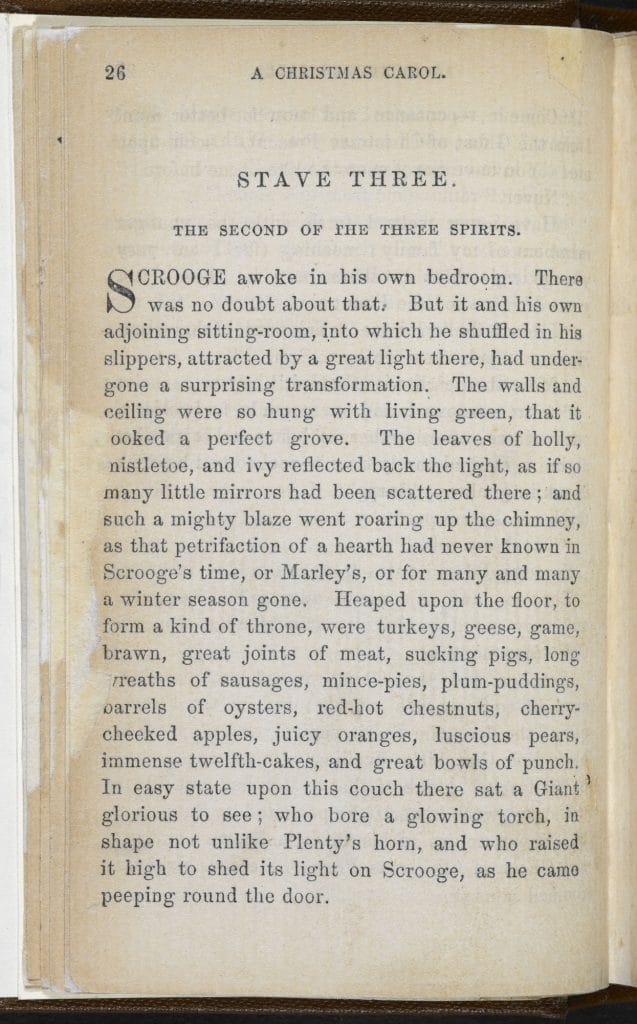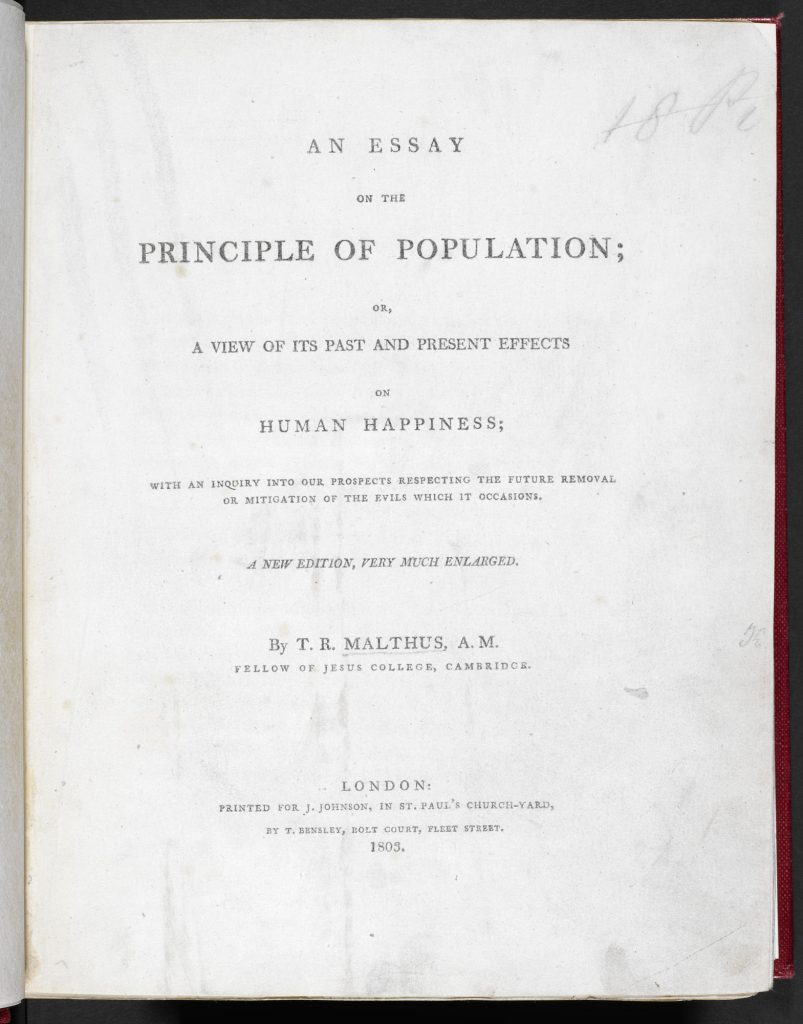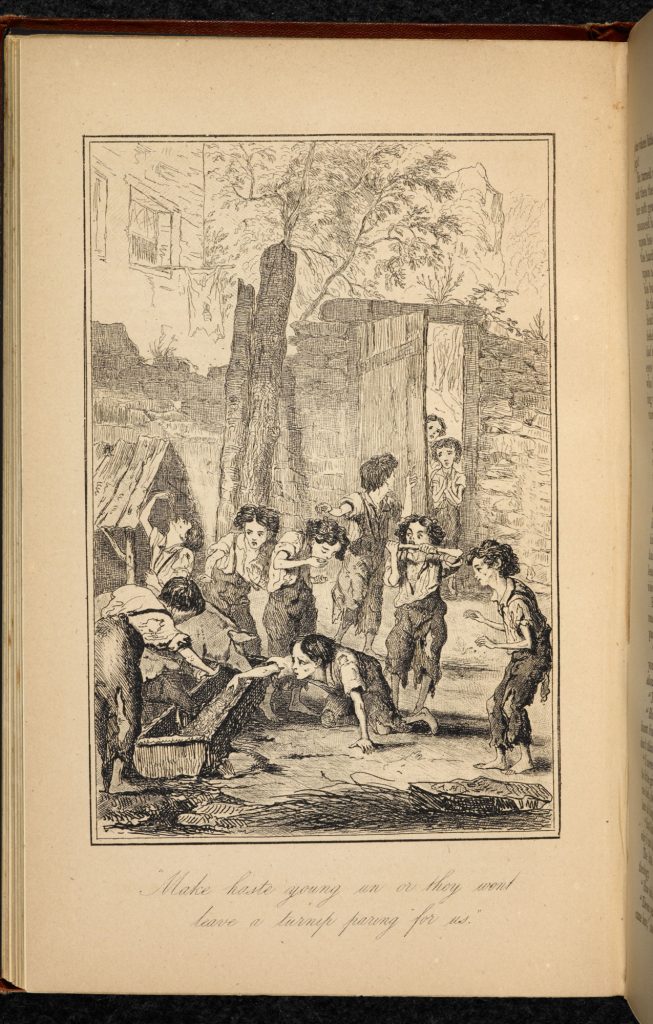
The origins of A Christmas Carol
Professor John Sutherland considers how Dickens’s A Christmas Carol engages with Victorian attitudes towards poverty, labour and the Christmas spirit.
Prince Albert – the newly installed husband of Queen Victoria – is popularly associated with institutionalising the British family Christmas, an institution which is still with us. It was Albert, for example, who brought from his native Germany the tannenbaum, or Christmas Tree. 1841 is the normally given as the date for this happy importation. The Christmas tree replaced the traditional British ‘yule log’ – wood designed to give winter warmth, not something to deck with pretty lights, fairies, favours and (round its base) presents. Both the tannenbaum and the Yule log (along with mistletoe) were incorporated into Christian festivity from pre-Christian pagan rituals associated with the seasonal turn of the year – the rebirth of the land and the green gods. There is no Biblical warrant for Christ’s day of birth being 25 December.
Shortly after the arrival of the Christmas tree into the British parlour, Dickens, with A Christmas Carol, institutionalised what one could call the modern ‘spirit of Christmas’. Dickens subtitled his story ‘A Ghost Story for Christmas’. The ghosts are imported from folklore and legend, not the Christian gospels. The famous spirit of Christmas designed by the artist John Leech for the first edition of A Christmas Carol clearly draws on classic pagan iconography:
Dickens had warm memories of his own childhood Christmases and, now the father of a young family (as was Prince Albert), made the annual event a merry holiday. Feasting, games, and domestic dramas were the order of the ‘twelve days of Christmas’ in the 1840s Dickens household.
Money lending, scratching pens and ghosts
A Christmas Carol opens with Ebenezer Scrooge in his chilly ‘counting house’ on Christmas Eve (Stave 1). Outside London, the ‘great wen’ is shrouded in filthy brown fog. It is the ‘hungry forties’. The 1840s saw huge distress among the working classes and mass starvation in Ireland. Chartism (a working-class reformist movement) raised the fearful possibility of revolution. It was a nervous time.
Opposite Scrooge’s door a dying woman is sitting in the gutter – ghosts of rich businessmen dancing around her. It is they who have brought her to this sad pass.
Since his partner Marley’s death, seven years previously, Scrooge is the sole proprietor Scrooge & Marley. He is a money lender. He lends money, but he is not inclined to part with money. Two gentlemen, soliciting charitable donations, are dismissed with an angry ‘Bah! Humbug!’. Another visitor, his nephew, injudiciously wishes his uncle a merry Christmas: ‘Merry Christmas!’, explodes Scrooge, ‘every idiot who goes about with “Merry Christmas” on his lips should be boiled with his own pudding!’ The nephew, like the two gentlemen, is ‘humbugged’ off (Stave 1).
At the end of his 12-hour day Scrooge dismisses his clerk, Bob Cratchit. Cratchit – his name evokes a scratching pen – is a ‘scrivener’. Before typewriters and photocopying machines, the necessary copying of business and legal documents was done long hand. The typewriter girl was 40 years in the future. Cratchit has one day’s holiday a year, and earns 15 shillings (75p) per six-day week: half a crown a day. On it he supports a large, happy, but chronically hard-up family. The family favourite is Tiny Tim, a little ‘cripple’ boy (on his father’s shoulder, in the illustration below):
That Christmas Eve Scrooge, alone in his cold empty house is destined to be haunted. First by his partner, Marley, doomed to wander forever as penance for his hard-heartedness.
Then, overnight, the miser is visited by three spirits of Christmas Past, Present, and Future. In the last visitation, Scrooge is shown his own gravestone and realises the worthlessness of a life devoted to money-grubbing.
Scrooge wakes up – it is Christmas morning and he is a changed man. From now on he will be good-hearted: good-hearted most of all to the Cratchit family and Tiny Tim, to whom he will be a year-round Father Christmas.
How a society treats its children
How a society treats its children, Dickens believed, is the true test of that society’s moral worth. His religious beliefs were complicated, as are most people’s. But very simply, he favoured the New Testament over the Old. He wrote a version of the gospels for his own children, The Life of our Lord, four years after A Christmas Carol. Dickens, we can assume from the centrality of childish innocence in his fiction, was particularly moved by Christ’s injunction: ‘Except ye … become as little children, ye shall not enter into the kingdom of heaven’. Christmas celebrates the birth of a child. So does all Dickens’s great fiction: not least A Christmas Carol.
The first stirrings of the tale can be found in a visit Dickens made to Manchester a month before he began writing. One of the great orators of his time (only fragments of his eloquence, alas, survive) he spoke at the city’s Athenaeum on 5 October.
It was a memorable evening for those present, and those who read accounts of the speech in the next day’s papers. As Dickens’s biographer, Michael Slater, describes:
Dickens dwelt on the terrible sights he had seen among the juvenile population in London’s jails and doss-houses and stressed the desperate need for educating the poor. This occasion seems to have put into his mind the idea for a [Christmas Eve tale] which should help to open the hearts of the prosperous and powerful towards the poor and powerless but which should also bring centrally into play the theme of memory that, as we have seen, was always so strongly associated with Christmas for him.
The Athenaeum speech was also an opening shot in his campaign, which bore fruit eight years later, to get a public library for the adult working classes in the city. Nor were children forgotten. They too needed the printed word. In the early 1840s Dickens took a particular interest in ‘ragged schools’. As he described them, in an article in 1846:
The name implies the purpose. They who are too ragged, wretched, filthy, and forlorn, to enter any other place: who could gain admission into no charity school, and who would be driven from any church door; are invited to come in here, and find some people not depraved, willing to teach them something, and show them some sympathy, and stretch a hand out, which is not the iron hand of Law, for their correction.
Industry, poverty and utilitarianism
Manchester – the ‘workshop of the world’ – was famous not merely for its industry but the utilitarian philosophy that drove it. It may not be clear what Scrooge’s line of business is. But his beliefs, before his change of heart, are crystal clear – pure Manchester.
‘Are there no workhouses?’ he asks, when the two gentleman ask for a charitable donation. If the poor die (like the poor woman outside his house) it will, he says, solve ‘the surplus population’ problem (Stave 3; Stave 1). Concern with over-population had been stimulated by the stern philosophy of Thomas Robert Malthus who foresaw catastrophe for England if its masses were not ‘checked’ by famine, war, or disease. For the more thoughtful, the anxiety was fostered by the census which, since 1821, had been counting how many inhabitants there were in the country. In 1841 the figure was approaching 29 million – there were serious doubts as to whether British agriculture could feed them, something which led to the repeal of the Corn Laws, in 1846, allowing cereals to be imported from the New World.
The 1840s were not merely ‘hungry’ but hard hearted. It was a philosophy embodied in Ebenezer Scrooge – not merely a solitary miser (like, for example, George Eliot’s Silas Marner) but the ‘spirit of the age’ in human (and, arguably, inhuman) form. Hard heads, hard hearts, good business. Soft heads and soft hearts lead to the bankruptcy court, Scrooge would have said. Dickens disagreed.
Children worked, like slaves, in Manchester factories (as Michael Slater points out, the chimneys in the background of John Leech’s illustration of the destitute children ‘Ignorance and Want’ are more reminiscent of Manchester’s industrial landscape than of London streets). Six months after A Christmas Carol was published the 1844 Factories Act decreed, however, that 9-13 year olds could only work nine hours a day, six days a week. This was regarded as a humane reform.
Why were they wanted for this work? Children were cheap labour but, more importantly, their fingers were small and dexterous. But the machines were dangerous. There were crippled Tiny Tims by the hundred in Manchester.
The modern reader – of whatever age – is less sensitive to sentimentality than our Victorian forebears. At Dickens’s readings from his novels, audiences would regularly be moved to open tears by, for example, the death of Little Nell in The Old Curiosity Shop, or the murder of Nancy in Oliver Twist. One suspects that many Victorian tears were shed over the foreseen (but happily forestalled) death of Tiny Tim.
Dickens designed the externals of his book with the meticulous care he applied to its contents. It would be, he instructed his publishers, a handsome five-shilling production: ‘Brown-salmon fine-ribbed cloth, blocked in blind and gold on front; in gold on the spine … all edges gilt’. Dickens spared no expense. John Leech’s half-dozen illustrations should be coloured, he instructed. The result was a book whose production costs, and relatively high price (five shillings), meant that this most popular of works returned, on its first 5,000-copy print run, small profit for Dickens.
The first edition shot off the bookshop shelves even before Christmas Day 1843. And A Christmas Carol has sold massively ever since. It is the most filmed, and TV-adapted of his works. And, one suspects, as long as there is Christmas, there will be Dickens’s wonderful tale alongside it and Tiny Tim’s benediction, ‘God Bless Us, Everyone’.
The text in this article is available under the Creative Commons License.
撰稿人: John Sutherland
John Sutherland is Lord Northcliffe Professor Emeritus at UCL. He has taught principally in the UK, at the University of Edinburgh and UCL, and in the US at the California Institute of Technology. He has written over thirty books. Among his fields of special interest are Victorian Literature and Publishing History. He is a well known writer and reviewer in the British and American press.




























